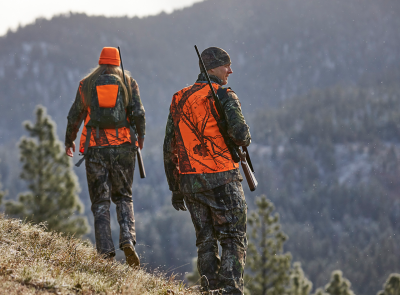The Lowdown on Upland Bird Hunting Safety
Your guide to staying safe (and having fun!) on the hunt.
3 Min. Read | Hunting
While every hunting discipline shares common safety considerations, many of the factors that make upland bird hunting so compelling also require specific awareness to ensure that every outing is fun and safe for all. That’s because upland bird hunting is generally a group activity, and often, that group includes both humans and dogs. On top of that, upland birds are not the most predictable creatures (to put it mildly), which further emphasizes the imperatives of muzzle control and precise awareness regarding the location of your hunting partners and canine friends at all times.
None of this is to suggest that upland hunting is inherently unsafe, only that it brings it own unique set of safety rules to the table. Of course, all the cross-discipline safety considerations such as proper firearm handling and appropriate dress also apply, but for the purposes of this post, we’re going to focus on upland-specific issues. Read on, and then get hunting!
Make a Plan. Then Follow it
While having a plan is critical for every hunting outing, no matter the discipline, it’s particularly critical when hunting in a group, and when dogs are present. Typically, groups of upland hunters will hunt in a line; this allows a 270-degree coverage for hunters on the ends of a line (but be aware of dogs!), while the center hunter(s) are limited to straight ahead shooting. Birds flush very fast, and require similarly speedy reflexes, so it’s imperative that all hunters know exactly where their companions are located at all times.

Quick tip:
The time to discuss plans is before you head into the field; be sure to gather the entire hunting party together, and take pains to confirm that everyone understands the plan and knows their place in the formation.
Muzzles Up
For the safety of both humans and dogs, it’s critical to keep gun muzzles pointed skyward. Shots at low-flying birds should be taken only if you are absolutely certain that you know the location of every dog and every hunting partner, and the best practice is to only shoot at birds that are flying at eye level or above. Remember: some of the best upland hunting takes place in areas with dense ground cover that makes it easy to lose track of dogs.
Keep Calm and Hunt on
It’s easy to get excited when dogs point; in fact, if you don’t get excited when a bird dog’s on point, you’re probably in the wrong sport. But keep that excitement in check, and advance at a quick-but-controlled pace, being sure that everyone maintains formation and is ready to shoot safely when the bird flushes. Remember: The safety of your entire hunting party depends on the skills and judgement of each individual member.
Canine Considerations
As any bird dog owner will tell you, hunting with a canine companion introduces a whole new level of excitement and satisfaction to the sport. There’s really nothing quite like being in the field with a dog you’ve trained and come to love, and the first time you see them on point is not a moment you’ll soon forget.
But in addition to the obvious considerations regarding firearms, hunting with dogs requires additional awareness to ensure the health and safety of people and pooches alike.
One of the most common errors new hunters make is not bringing enough water for both themselves and their fur-covered friends. Dogs generally require about one ounce of water per pound, per day, but strenuous activity and warm temperatures can easily increase that amount by 50% or more. Long story short: Don’t skimp on water, and be sure to offer it to your dog at regular intervals throughout the day.
Another less-obvious consideration is that dogs tend to follow their noses, and their noses might not take them where you were planning to go. While it’s important to maintain control of your dog at all times, and to hold them to a distance you can control, it’s also wise to be prepared for your dog to lead you in unexpected directions, and to always have a plan for getting back to your vehicle. This is where a GPS tracking collar or other locating device comes in really, really handy. That said, don’t forget that batteries can fail, phones can get lost or break, and cellular service can go down. Always carry an analog compass and, most importantly, know how to use it!
Related Stories













